Wenzhe Li
The Ever-Evolving Science Exam
Jul 22, 2025Abstract:As foundation models grow rapidly in capability and deployment, evaluating their scientific understanding becomes increasingly critical. Existing science benchmarks have made progress towards broad **Range**, wide **Reach**, and high **Rigor**, yet they often face two major challenges: **data leakage risks** that compromise benchmarking validity, and **evaluation inefficiency** due to large-scale testing. To address these issues, we introduce the **Ever-Evolving Science Exam (EESE)**, a dynamic benchmark designed to reliably assess scientific capabilities in foundation models. Our approach consists of two components: 1) a non-public **EESE-Pool** with over 100K expertly constructed science instances (question-answer pairs) across 5 disciplines and 500+ subfields, built through a multi-stage pipeline ensuring **Range**, **Reach**, and **Rigor**, 2) a periodically updated 500-instance subset **EESE**, sampled and validated to enable leakage-resilient, low-overhead evaluations. Experiments on 32 open- and closed-source models demonstrate that EESE effectively differentiates the strengths and weaknesses of models in scientific fields and cognitive dimensions. Overall, EESE provides a robust, scalable, and forward-compatible solution for science benchmark design, offering a realistic measure of how well foundation models handle science questions. The project page is at: https://github.com/aiben-ch/EESE.
MATH-Perturb: Benchmarking LLMs' Math Reasoning Abilities against Hard Perturbations
Feb 10, 2025



Abstract:Large language models have demonstrated impressive performance on challenging mathematical reasoning tasks, which has triggered the discussion of whether the performance is achieved by true reasoning capability or memorization. To investigate this question, prior work has constructed mathematical benchmarks when questions undergo simple perturbations -- modifications that still preserve the underlying reasoning patterns of the solutions. However, no work has explored hard perturbations, which fundamentally change the nature of the problem so that the original solution steps do not apply. To bridge the gap, we construct MATH-P-Simple and MATH-P-Hard via simple perturbation and hard perturbation, respectively. Each consists of 279 perturbed math problems derived from level-5 (hardest) problems in the MATH dataset (Hendrycksmath et. al., 2021). We observe significant performance drops on MATH-P-Hard across various models, including o1-mini (-16.49%) and gemini-2.0-flash-thinking (-12.9%). We also raise concerns about a novel form of memorization where models blindly apply learned problem-solving skills without assessing their applicability to modified contexts. This issue is amplified when using original problems for in-context learning. We call for research efforts to address this challenge, which is critical for developing more robust and reliable reasoning models.
Towards Principled Superhuman AI for Multiplayer Symmetric Games
Jun 06, 2024
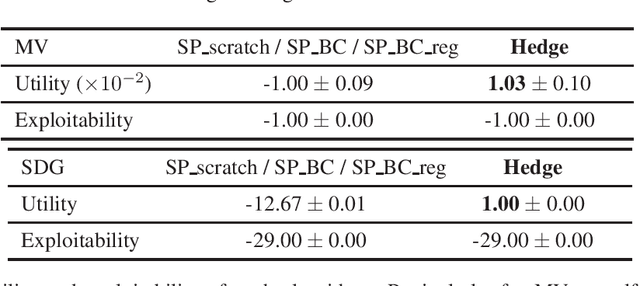
Abstract:Multiplayer games, when the number of players exceeds two, present unique challenges that fundamentally distinguish them from the extensively studied two-player zero-sum games. These challenges arise from the non-uniqueness of equilibria and the risk of agents performing highly suboptimally when adopting equilibrium strategies. While a line of recent works developed learning systems successfully achieving human-level or even superhuman performance in popular multiplayer games such as Mahjong, Poker, and Diplomacy, two critical questions remain unaddressed: (1) What is the correct solution concept that AI agents should find? and (2) What is the general algorithmic framework that provably solves all games within this class? This paper takes the first step towards solving these unique challenges of multiplayer games by provably addressing both questions in multiplayer symmetric normal-form games. We also demonstrate that many meta-algorithms developed in prior practical systems for multiplayer games can fail to achieve even the basic goal of obtaining agent's equal share of the total reward.
FightLadder: A Benchmark for Competitive Multi-Agent Reinforcement Learning
Jun 04, 2024



Abstract:Recent advances in reinforcement learning (RL) heavily rely on a variety of well-designed benchmarks, which provide environmental platforms and consistent criteria to evaluate existing and novel algorithms. Specifically, in multi-agent RL (MARL), a plethora of benchmarks based on cooperative games have spurred the development of algorithms that improve the scalability of cooperative multi-agent systems. However, for the competitive setting, a lightweight and open-sourced benchmark with challenging gaming dynamics and visual inputs has not yet been established. In this work, we present FightLadder, a real-time fighting game platform, to empower competitive MARL research. Along with the platform, we provide implementations of state-of-the-art MARL algorithms for competitive games, as well as a set of evaluation metrics to characterize the performance and exploitability of agents. We demonstrate the feasibility of this platform by training a general agent that consistently defeats 12 built-in characters in single-player mode, and expose the difficulty of training a non-exploitable agent without human knowledge and demonstrations in two-player mode. FightLadder provides meticulously designed environments to address critical challenges in competitive MARL research, aiming to catalyze a new era of discovery and advancement in the field. Videos and code at https://sites.google.com/view/fightladder/home.
A Survey on Transformers in Reinforcement Learning
Jan 08, 2023Abstract:Transformer has been considered the dominating neural architecture in NLP and CV, mostly under a supervised setting. Recently, a similar surge of using Transformers has appeared in the domain of reinforcement learning (RL), but it is faced with unique design choices and challenges brought by the nature of RL. However, the evolution of Transformers in RL has not yet been well unraveled. Hence, in this paper, we seek to systematically review motivations and progress on using Transformers in RL, provide a taxonomy on existing works, discuss each sub-field, and summarize future prospects.
Flow to Control: Offline Reinforcement Learning with Lossless Primitive Discovery
Dec 02, 2022



Abstract:Offline reinforcement learning (RL) enables the agent to effectively learn from logged data, which significantly extends the applicability of RL algorithms in real-world scenarios where exploration can be expensive or unsafe. Previous works have shown that extracting primitive skills from the recurring and temporally extended structures in the logged data yields better learning. However, these methods suffer greatly when the primitives have limited representation ability to recover the original policy space, especially in offline settings. In this paper, we give a quantitative characterization of the performance of offline hierarchical learning and highlight the importance of learning lossless primitives. To this end, we propose to use a \emph{flow}-based structure as the representation for low-level policies. This allows us to represent the behaviors in the dataset faithfully while keeping the expression ability to recover the whole policy space. We show that such lossless primitives can drastically improve the performance of hierarchical policies. The experimental results and extensive ablation studies on the standard D4RL benchmark show that our method has a good representation ability for policies and achieves superior performance in most tasks.
* 13pages
Improving Graph-Based Text Representations with Character and Word Level N-grams
Oct 12, 2022



Abstract:Graph-based text representation focuses on how text documents are represented as graphs for exploiting dependency information between tokens and documents within a corpus. Despite the increasing interest in graph representation learning, there is limited research in exploring new ways for graph-based text representation, which is important in downstream natural language processing tasks. In this paper, we first propose a new heterogeneous word-character text graph that combines word and character n-gram nodes together with document nodes, allowing us to better learn dependencies among these entities. Additionally, we propose two new graph-based neural models, WCTextGCN and WCTextGAT, for modeling our proposed text graph. Extensive experiments in text classification and automatic text summarization benchmarks demonstrate that our proposed models consistently outperform competitive baselines and state-of-the-art graph-based models.
Latent-Variable Advantage-Weighted Policy Optimization for Offline RL
Mar 16, 2022
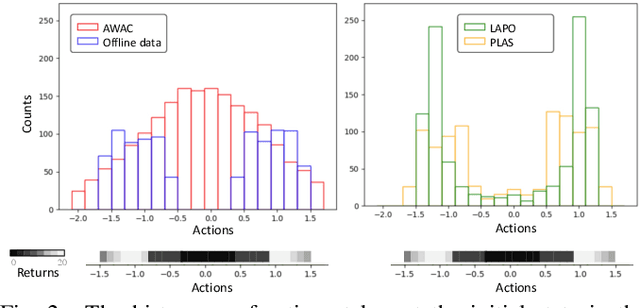

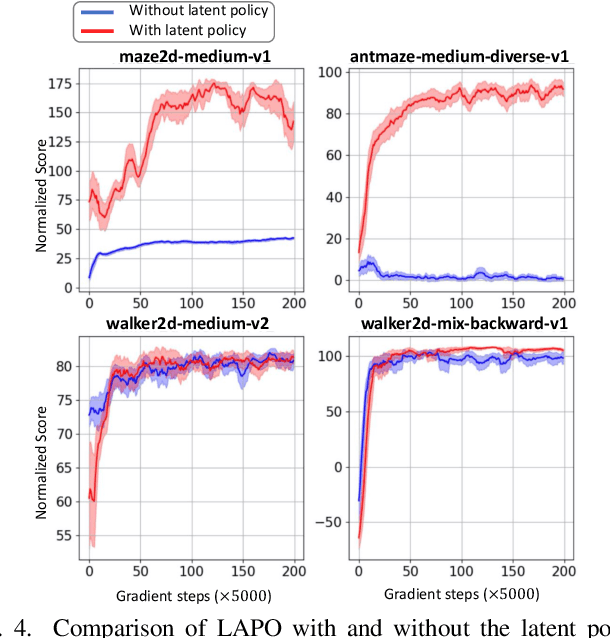
Abstract:Offline reinforcement learning methods hold the promise of learning policies from pre-collected datasets without the need to query the environment for new transitions. This setting is particularly well-suited for continuous control robotic applications for which online data collection based on trial-and-error is costly and potentially unsafe. In practice, offline datasets are often heterogeneous, i.e., collected in a variety of scenarios, such as data from several human demonstrators or from policies that act with different purposes. Unfortunately, such datasets can exacerbate the distribution shift between the behavior policy underlying the data and the optimal policy to be learned, leading to poor performance. To address this challenge, we propose to leverage latent-variable policies that can represent a broader class of policy distributions, leading to better adherence to the training data distribution while maximizing reward via a policy over the latent variable. As we empirically show on a range of simulated locomotion, navigation, and manipulation tasks, our method referred to as latent-variable advantage-weighted policy optimization (LAPO), improves the average performance of the next best-performing offline reinforcement learning methods by 49% on heterogeneous datasets, and by 8% on datasets with narrow and biased distributions.
Rethinking Goal-conditioned Supervised Learning and Its Connection to Offline RL
Feb 14, 2022

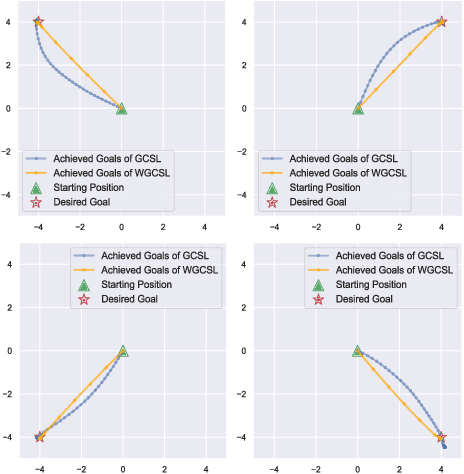
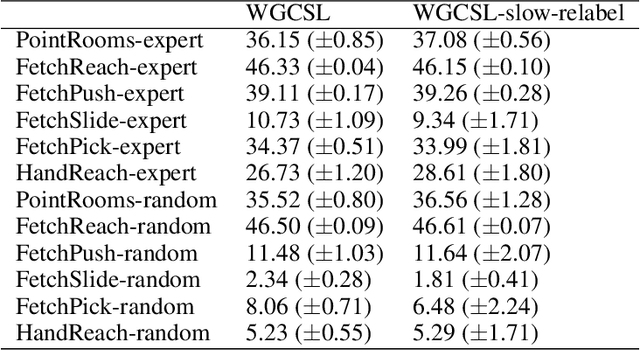
Abstract:Solving goal-conditioned tasks with sparse rewards using self-supervised learning is promising because of its simplicity and stability over current reinforcement learning (RL) algorithms. A recent work, called Goal-Conditioned Supervised Learning (GCSL), provides a new learning framework by iteratively relabeling and imitating self-generated experiences. In this paper, we revisit the theoretical property of GCSL -- optimizing a lower bound of the goal reaching objective, and extend GCSL as a novel offline goal-conditioned RL algorithm. The proposed method is named Weighted GCSL (WGCSL), in which we introduce an advanced compound weight consisting of three parts (1) discounted weight for goal relabeling, (2) goal-conditioned exponential advantage weight, and (3) best-advantage weight. Theoretically, WGCSL is proved to optimize an equivalent lower bound of the goal-conditioned RL objective and generates monotonically improved policies via an iterated scheme. The monotonic property holds for any behavior policies, and therefore WGCSL can be applied to both online and offline settings. To evaluate algorithms in the offline goal-conditioned RL setting, we provide a benchmark including a range of point and simulated robot domains. Experiments in the introduced benchmark demonstrate that WGCSL can consistently outperform GCSL and existing state-of-the-art offline methods in the fully offline goal-conditioned setting.
Estimating High Order Gradients of the Data Distribution by Denoising
Nov 08, 2021



Abstract:The first order derivative of a data density can be estimated efficiently by denoising score matching, and has become an important component in many applications, such as image generation and audio synthesis. Higher order derivatives provide additional local information about the data distribution and enable new applications. Although they can be estimated via automatic differentiation of a learned density model, this can amplify estimation errors and is expensive in high dimensional settings. To overcome these limitations, we propose a method to directly estimate high order derivatives (scores) of a data density from samples. We first show that denoising score matching can be interpreted as a particular case of Tweedie's formula. By leveraging Tweedie's formula on higher order moments, we generalize denoising score matching to estimate higher order derivatives. We demonstrate empirically that models trained with the proposed method can approximate second order derivatives more efficiently and accurately than via automatic differentiation. We show that our models can be used to quantify uncertainty in denoising and to improve the mixing speed of Langevin dynamics via Ozaki discretization for sampling synthetic data and natural images.
 Add to Chrome
Add to Chrome Add to Firefox
Add to Firefox Add to Edge
Add to Edge